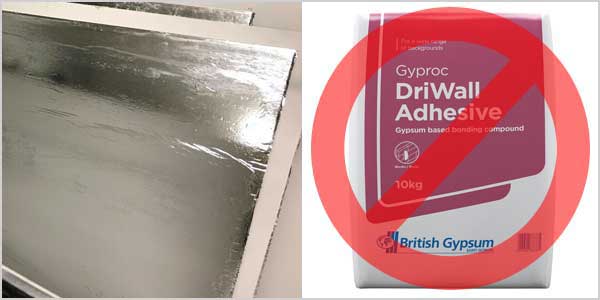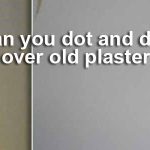
If you want to add an extra layer of moisture resistance to a wall or ceiling, then foil backed plasterboard’s can be a great solution.
The foil acts as a vapour barrier, which prevents moisture from soaking into the back of the board.
This means, foil back boards can be a great solution when you want to avoid damp penetrating through, causing damp patches on interior surfaces.
One good place to use foil backed boards, is on walls that previously suffered with damp. In many instances the wall may still contain trapped salts and moisture. By using vapour barrier boards, you can stop this moisture from ever seeping through.
It can also be a good solution for the internal side of cold exterior walls.
By attaching your boards to timber battens on the wall, you will separate your boards from the cold surface and create a small cavity behind.
This will allow air to circulate behind the boards and raise the temperature or the internal surface. Both of which, will prevent condensation, plus the foil back will add an additional layer of protection.
Basically, if you have a situation where there is a small risk of moisture over time, then foil backed boards can be a great solution. With that said, they should never be used to treat (or hide) more serious damp issues.
So, can you dab foil back boards?
The foil vapour barrier is usually glued to the back of the plasterboard and is often quite easy to peel off. For this reason, it is not suitable for dot dab with a plaster board adhesive.
The boards are too heavy, and they will simply peel away from the foil back and fall of the wall. Even if the vapour barrier didn’t peel off, it is completely moisture resistant, so the adhesive has nothing to adhere to and the boards would pop off the dabs.
In short, you should never dot and dab using foil backed boards!
The correct way to install foil backed boards
This type of plasterboard is far more suitable for fixing mechanically. For example, using screws and fixing to timber or metal stud work.
Another option, which is probably the closest alternative to dot and dab, would be fixing to timber battens on the wall.
Either of these can be a good solution depending on the job you are doing.
If you were considering dot and dab to fix your boards to a wall, then timber battens will probably be the closest solution in terms of finish. Battens and boards would take up around the same space as dabs plus boards.
When using this method with 1200 x 2400mm boards, you should fix treated timber battens to the wall, at 400mm intervals. This will allow you to fix your boards without needing to cut the width. Although, they will probably need a cut to shorten them to ceiling height.
Make sure that 1200mm hits the middle of your batten, from the wall you are starting to board. By doing this, each board on either side will fall halfway on the timber batten with a 1200mm centre.
If you opt for smaller boards, check the width. Some boards come in 900mm wide. If this is the case, you should attach your battens at 450mm centres.
Foil backed boards and penetrating damp
Whilst foil back boards do provide a vapour barrier, this does not mean they should be used to treat more serious cases of damp.
It may seem that you could easily cover up a damp wall with a foil backed board and forget about it. This could be true to some extent, as the small cavity and the vapour barrier, will make it more difficult for water to enter your property.
However, doing this will not solve the underlying issue. It is just the same as using a damp proof paint to fix a bigger problem. It might work for a while, but in the long run the issue will get worse. Eventually the damp will build up and it will find a way in.
Also, internal damp problems might not be the only damage that you need to worry about. Penetrating damp can cause a variety of different issues, Including:
- Damage to bricks due to spalling
- Erosion of pointing, leading to even more moisture penetration
- Rotting of structural timbers
- The growth and spread of mould.
The point here, is covering up a more serious damp issue, will rarely solve it in the long term.
It is far better to resolve the main problem and then use additional measures, such as foil backed boards, to add a secondary layer of protection.
Getting help to find the problem
Finding the source of a damp problem can sometimes be easy. If there is an obvious defect, that can be seen from outside, you can either fix it yourself, or hire someone to do the repair before you board inside.
On the other hand, if it is a less obvious issue, you can hire a professional damp proofing specialist, to investigate further.
The advantage of this approach, is a professional with more experience, is much more likely to fully solve the issue.
If you do decide to hire someone, the best option is to use a comparison website for local damp specialists.
For this we recommend a company called Bark, they have a large database of fully qualified damp professionals throughout the UK.
There are a few main advantages to this type of service, these include:
- Price – Due to multiple damp companies quoting for the same job, prices can be extremely competitive.
- You can view all their company information, including qualifications and certifications.
- They will have been fully verified and vetted by the comparison service.
- You will be able to see reviews from previous customers.
This means you can be confident you are hiring a reputable local company, at the best possible price.
To get up to 5 local damp proofing quotes click here
Conclusion
In conclusion, you should never dot and dab foil backed plaster boards. If you do make this mistake, your boards will likely end up falling off.
There are basically two points of failure when using vapour boards with drywall adhesive.
- Firstly, the foil usually peels away very easily
- And secondly, the adhesive will not be able to get any suction on the non-porous foil surface.
Either way the result is the same. Your boards no longer stuck to the wall!
Hopefully, the methods in this article give you a few alternative solutions, to help you get the benefit of using a foil backed plaster board.


